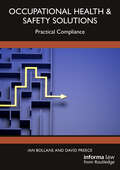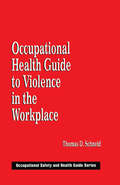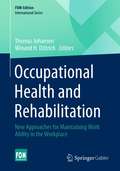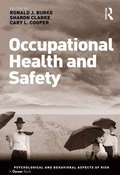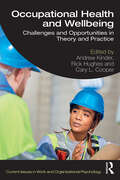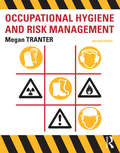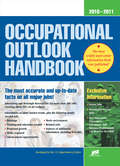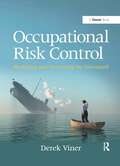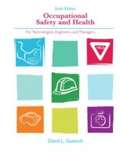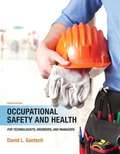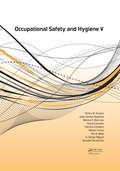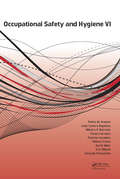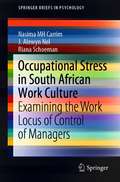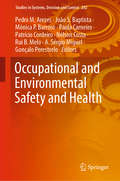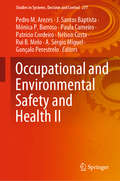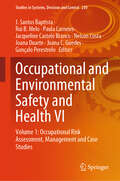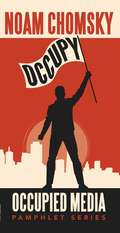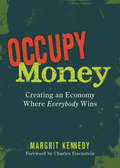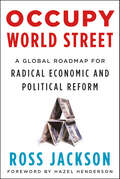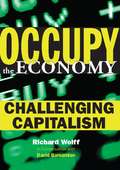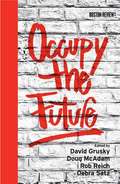- Table View
- List View
Occupational Health & Safety Solutions: Practical Compliance
by David Preece Ian BollansHealth and safety legislation places significant responsibilities on employers and managers to protect the health and safety of their workers, but the subject area is seen as both complex and technical in nature, often requiring the input of professionals. This book dispels these myths by taking a unique approach, allowing somebody with little or no knowledge of the subject to understand their legal duties and then take a practical step-by-step approach to control workplace risks and prevent accidents.Occupational Health & Safety Solutions: Practical Compliance is a reworking and updating of Jordan Publishing’s Health and Safety Management, published by LexisNexis from 1997 to 2023. The book takes a comprehensive approach by covering the main subject areas of occupational health and safety and is relevant to all types of workplaces. It provides enough background knowledge for the reader to understand what the law requires, and what needs to be done to achieve compliance, with the main emphasis being on practical application. Providing the reader with the ability to manage health and safety through a process of flowcharts, diagrams, and extensive checklists, the book draws on the expertise of the authors and current best practice within industry. Each chapter sets out a clear, practical approach to identifying and managing risks, thereby enabling a robust and successful health and safety management system to be established in any workplace.The book is written for non-safety professionals such as managers and directors who want to discharge and manage their health and safety responsibilities in their workplace without the need to engage a consultant. It will also appeal to the safety professional by providing an authoritative guide to current best practice together with the practicalities of managing health and safety risks.
Occupational Health Guide to Violence in the Workplace (Occupational Safety And Health Guide Ser. #2)
by Thomas D. Schneid20 murders every week. 18,000 assaults in the same time. All on the job.Sharp increases in workplace violence continue to take an unfortunate toll on American business-and its employees, families and communities. Preventative measures may be well-intentioned, but pose troubling conflicts in themselves, pitting each employee's privacy vs. overall worker protection.A full-self evaluation of your business and its personnel may be the key to safeguard against workplace violence. Thomas D. Schneid's Occupational Health Guide to Violence in the Workplace provides the important guidelines for that careful, all-encompassing examination.Most books on workplace violence focus on psychological profiles. In a change of pace, Schneid examines the issue from a safety/health professional's viewpoint, taking all angles, legal issues, and potential ramifications into account. Chapters focus on not only in-house efforts to prevent violent incidents, but also government and legal standards directly or indirectly related to worker's rights and corporate liability.Make every effort to prevent workplace violence from hitting home: start with advice from the Occupational Health Guide to Violence in the Workplace
Occupational Health and Rehabilitation: New Approaches for Maintaining Work Ability in the Workplace (FOM-Edition)
by Thomas Johansen Winand H. DittrichSustaining a healthy and productive work environment for employees with health issues and work disabilities or those returning to work after sick leave may present a challenge to employers. This publication offers unique insights into occupational health and rehabilitation, covering international perspectives as well as a variety of health-related disciplines. Policymakers, employers, employees, researchers and students will find new approaches to questions of how to maintain work ability and health in the workplace: Which motives influence strategic planning in the healthcare and employment sector? How can the return of employees after sick leave be facilitated? How best to implement innovations while keeping the workplace safe and healthy? And how does occupational rehabilitation benefit from evidence-based knowledge transfer?Contents• Work Ability and Work Disability• Return to Work• Work and Health• Work and Innovation
Occupational Health and Safety: Individual, Work And Organizational Factors (Psychological and Behavioural Aspects of Risk)
by Sharon ClarkeWorkplace accidents and errors cost organizations hundreds of billions of dollars each year, and the injured workers and their families endure considerable financial and emotional suffering. It's obvious that increasing employee health and safety pays. The accumulating evidence shows that investing in occupational health and safety results in improved financial and social responsibility performance. There are extensive country differences and wide occupational differences in the incidence of accidents and errors. The International Labour Organization (ILO) estimates that every year there are 2.2 million fatal and 270 million non-fatal accidents or occupational diseases worldwide. Occupational Health and Safety looks at the research into what causes accidents and errors in the workplace. In line with other titles in the series, Occupational Health and Safety emphasizes the psychological and behavioral aspects of risk in organizations. It highlights how organizations differ in their health and safety performance, with case studies throughout and best practices. Key elements focus on: employee selection and training, fostering employee understanding, participation and engagement in health and safety matters, developing a health and safety culture at organizational and group/work unit levels, communicating and reinforcing safe workplace practices and bench-marking one's organization against the industry leaders. The contributors to this volume come from various countries, reflecting unique interest and knowledge in particular areas.
Occupational Health and Wellbeing: Challenges and Opportunities in Theory and Practice (Current Issues In Work And Organizational Psychology Ser.)
by Cary Cooper Rick Hughes Andrew KinderThis book bridges the gap between theory and practice, incorporating real-world case studies to show how organisations and leaders can adapt after the global unrest and uncertainty caused by the COVID-19 pandemic and more recent challenges. Drawing from expert opinions across the world to highlight the current challenges and opportunities within this sector, it explores how these ideas can be effectively applied within the workplace. The book covers a wealth of topical and relevant themes that include defining wellbeing in a modern world, toxic leadership, mental health first aid, the application of positive psychology, and what the ‘new normal’ might look like. Together, these contributions offer a rich look into how Occupational Health and Wellbeing practices have developed, struggled and thrived. The COVID-19 pandemic forced many organisations to adapt fast and became the most significant accelerator in recent times for embracing, enhancing and improving employee health and wellbeing. Understanding this, the book demonstrates how Occupational Health and Wellbeing continues to rise on the corporate agenda as a key contributor to employee satisfaction, engagement and retention, increased financial stability and overall organisational success. The book is essential reading for senior executives, leaders and professionals involved in occupational health, human resources, health, safety and wellbeing, people support, people development, employee assistance, counselling as well as students within organisational and occupational psychology.
Occupational Hygiene and Risk Management: A Multimedia Package
by Megan TranterThe science of occupational hygiene is growing, as is awareness amongst Australian employers of the importance of minimising occupational health and safety risk.Occupational Hygiene and Risk Management offers an innovative approach to learning about the practice and principles of occupational hygiene and managing risk in the workplace. This new edition of this widely used textbook has been extensively updated with new material on legislation and Australian and New Zealand standards. It also includes expanded sections on risk analysis and management. The theory of occupational hygiene is brought to life through case studies, illustrations and practical examples.Occupational hygiene aims to minimise ill-health from exposure to hazardous events by a process of identification, evaluation and control. These three stages form the foundation of this textbook as physical, psychological and emotional health risks are examined across the following topics:* Hazard identification* Dusts and particulate* Metals* Chemical contaminants* Noise and vibration* Heat and cold* Radiation and pressure* Biological hazards* Ergonomics* Risk analysis* Control* Risk managementOccupational Hygiene and Risk Management is accompanied by a website with discussion questions, case studies, further readings and teacher resources, creating an invaluable resource for students and professionals.Visit www.allenandunwin.com/OHRM
Occupational Outlook Handbook 2010-2011
by Editors at JIST US Department of LaborA career classic with 300 job descriptions and exclusive green jobs info helpful to job seekers, new graduates, students, career changers, teachers, career counselors, librarians.
Occupational Risk Control: Predicting and Preventing the Unwanted
by Derek VinerOccupational Risk Control contains a practical theory of risk based on the principles of the physical sciences. The book provides details of the implications of such theory for real-world practice that will be of value to the legislator, general or specialist risk engineer, scientist, academic, student, risk/safety practitioners as well as managers of industrial or commercial undertakings. The contents are a result of over 40 years of experience in researching, teaching and consulting. The theoretical base is relevant peer-reviewed physical sciences literature. Such literature points out the necessity of understanding the principles that enable processes resulting in damage and loss to be explained and it enables the risk arising from the uncertainty of these processes to be objectively defined, described as well as estimated using real number values. Of these principles and their applications a student once remarked “this should be compulsory study for all engineering students”. A critical assessment of the pervasive but unscientific accident terminology is included to assist the reader to reflect on the value of this. In a field in which there is a plethora of commercial and pseudo-academic practical tools based on accident theory, this text provides a foundation for the thinking academic and practitioner to critically evaluate the meaning, scope and value of such tools. The text has chapters on accident theory, damage process models, risk, risk estimation, risk control, risk evaluation, the classification and analysis of risks, risk numeracy, the management of risks in general and the management of technical risks in particular. There are notes on accident investigation and the role of the risk adviser. A substantial glossary of terms is included. The text is supported by a dedicated web site (www.derekviner.com) which contains discussion and examples of topics as well as a blog.
Occupational Safety and Health For Technologists, Engineers, and Managers (Sixth Edition)
by David L. GoetschKnown for its comprehensive coverage, this book covers all aspects of occupational safety and health in today's global workplace. The book follows a logical sequence that provides a historical perspective and overview, covers the laws and regulations, discusses the human element, examines hazard assessment, prevention, and control, and covers management of safety and health. This edition features updated OSHA standards and contemporary topics such as safety culture, safety's role in global competitiveness, workplace violence, natural disasters and terrorism. Includes the most up-to-date coverage of occupational safety and health, including: The global impact of accidents and injuries; Obesity and accident causation; Common accident investigation mistakes to avoid; Participatory ergonomics; Preventing arc flash injuries; Emergency planning for workers with disabilities; Safely resuming business after a disaster; Occupational safety and health management systems (OSHMS); Safety as a promotion tool. An excellent reference for all industries.
Occupational Safety and Health for Technologists, Engineers, and Managers Eighth Edition
by David L. GoetschThis comprehensive, extensively updated text covers all aspects of occupational safety and health in today's global workplace. A major revision, Occupational Safety and Health for Technologists, Engineers, and Managers, 8e, presents new and revised regulations, emerging approaches and trends, updated statistics, and other new material of significant importance to students and practitioners in the field. Among the dozens of new topics covered: ROI for safety/health investments; Heinrich's theory; Worker's Compensation lawsuits; fall protection; hard hat ratings; PPE for cold work environments; indoor air quality investigations; fungal growth assessment; nanoscale materials; and noise reduction ratings. Clear, up-to-date, and logically sequenced, this text begins with historical perspective and overview, then covers laws and regulations; human elements; hazard assessment, prevention, and control; and key management issues. Each chapter contains case studies to promote classroom discussion; at least one safety fact or myth designed to engage students; and review questions to test mastery and promote critical thinking.
Occupational Safety and Hygiene V: Selected papers from the International Symposium on Occupational Safety and Hygiene (SHO 2017), April 10-11, 2017, Guimarães, Portugal
by Pedro M. Arezes João Santos Baptista Rui B. Melo Mónica P. Barroso, Paula Carneiro, Patrício Cordeiro & Nélson Costa A. Sérgio Miguel & Gonçalo PerestreloOccupational Safety and Hygiene V contains selected contributions from the International Symposium on Occupational Safety and Hygiene (SHO 2017, 10-11 April 2017, Guimarães, Portugal). The contributions focus on a wide range of topics, including: - occupational safety- risk assessment- safety management- ergonomics- management systems- environmental ergonomics- physical environments- construction safety, and- human factors Occupational Safety and Hygiene V is mainly based on research carried out at universities and other research institutions, but also includes practical studies developed by OHS Practitioners within companies. Accordingly, this book will be a helpful text to get acquainted with the state-of-the-art in research in these domains, as well as with some practical tools and approaches that are currently used by OHS professionals worldwide.
Occupational Safety and Hygiene VI: Book chapters from the 6th International Symposium on Occupation Safety and Hygiene (SHO 2018), March 26-27, 2018, Guimarães, Portugal
by Pedro M. Arezes João Santos Baptista Monica P. Barroso Paula Carneiro Patrício Cordeiro Nelson Costa Rui B. Melo A. Sergio Miguel Gonçalo PerestreloOccupational Safety and Hygiene VI collects recent papers of selected authors from 21 countries in the domain of occupational safety and hygiene (OSH). The contributions cover a wide range of topics, including:- Occupational safety- Risk assessment- Safety management- Ergonomics- Management systems- Environmental ergonomics- Physical environment- Construction safety, and- Human factors Occupational Safety and Hygiene VI represents the state-of-the-art on the above mentioned domains, and is based on research carried out at universities and other research institutions. Some contributions focus more on practical case studies developed by OSH practitioners within their own companies. Hence, the book provides practical tools and approaches currently used by OHS practitioners in a global context.
Occupational Stress in South African Work Culture: Examining the Work Locus of Control of Managers (SpringerBriefs in Psychology)
by Nasima MH Carrim J. Alewyn Nel Riana SchoemanThis book explores avenues for organisations to better understand the origins of occupational stress so as to enable their managerial employees to effectively manage stress levels. By way of the work locus of control as a personality variable, the book identifies stressors both within and outside the organisation that underpin high stress levels in organisational culture. In grappling with what is required in the new workforce of ‘Generation Y’ millennials in a hyper-networked and mobile age, the authors present examples from everyday professional situations in South Africa to contribute to critical understanding of today’s working world. By applying neuroscientific principles developed from a foundation of empirical research, the authors introduce the concepts of a 'red zone’ and ‘blue zone' to explain differences between the brain areas controlled either by its stem-limbic areas, or the limbic-cortical cortex areas, respectively. This becomes a psychological shorthand for describing and applying knowledge to encourage practitioners in leadership and management roles to achieve desired behaviour outcomes, and to establish a framework for understanding employee values and worldviews. The book is relevant to practitioners, postgraduate students and researchers interested in industrial psychology, personality psychology, business management and human resources.
Occupational and Environmental Safety and Health (Studies in Systems, Decision and Control #202)
by Pedro M. Arezes Paula Carneiro Patrício Cordeiro Rui B. Melo Gonçalo Perestrelo João S. Baptista Mónica P. Barroso Nélson Costa A. Sérgio MiguelThis book explores a number of important issues in the area of occupational safety and hygiene. Presenting both research and best practices for the evaluation of occupational risk, safety and health in various types of industry, it particularly focuses on occupational safety in automated environments, innovative management systems and occupational safety in a global context. The different chapters examine the perspectives of all those involved, such as managers, workers and OSH professionals. Based on selected contributions presented at the 15th International Symposium on Occupational Safety and Hygiene (SHO 2019), held on 15–16 April, 2019, in Guimarães, Portugal, the book serves as a timely reference guide and source of inspiration to OSH researchers, practitioners and organizations operating in a global context.
Occupational and Environmental Safety and Health II (Studies in Systems, Decision and Control #277)
by Pedro M. Arezes Paula Carneiro Patrício Cordeiro Rui B. Melo Gonçalo Perestrelo Mónica P. Barroso Nélson Costa A. Sérgio Miguel J. Santos BaptistaThis book explores a number of important issues in the area of occupational safety and hygiene. Presenting both research and best practices for the evaluation of occupational risk, safety and health in various types of industry, it particularly focuses on occupational safety in automated environments, innovative management systems and occupational safety in a global context. The different chapters examine the perspectives of all those involved, such as managers, workers and OSH professionals. Based on selected contributions presented at the 16th International Symposium on Occupational Safety and Hygiene (SHO 2020), held on 6–7 April, 2020, in Porto, Portugal, the book serves as a timely reference guide and source of inspiration to OSH researchers, practitioners and organizations operating in a global context.
Occupational and Environmental Safety and Health VI: Volume 1: Occupational Risk Assessment, Management and Case Studies (Studies in Systems, Decision and Control #230)
by Paula Carneiro Nelson Costa Rui B. Melo Gonçalo Perestrelo J. Santos Baptista Joana Duarte Jacqueline Castelo Branco Joana C. GuedesThis book gathers cutting-edge research and best practices relating to occupational risk and safety management, healthcare, and ergonomics. It covers strategies for different industries, such as construction, chemical, and healthcare. It emphasizes challenges posed by automation, discusses solutions offered by technologies, and reports on case studies carried out in different countries. Chapters are based on selected contributions to the 21st International Symposium on Occupational Safety and Hygiene (SHO 2024), held on July 4-5, 2024, in Porto, Portugal. By reporting on different perspectives, such as the ones from managers, employees, and OSH professionals, and covering timely issues, such as implications of telework, issues related to gender inequality and applications of machine learning techniques in occupational health, this book offers extensive information and a source of inspiration to OSH researchers, practitioners, and organizations operating in both local and global contexts. This is the first volume of a 2-volume set.
Occupy
by Noam ChomskyNoam Chomsky discusses the Occupy movement, democracy, class war, the economy and the prospects for long term social change in light of global threats like climate change and nuclear proliferation. Chomsky praises the efforts of Occupy Wall Street and advocates education, workplace democracy, organizing and community outreach to develop the mass base of popular support needed to restore and sustain genuine people-powered democracy.
Occupy Management: Inspirations and Ideas for Self-Organization and Self-Management
by Monika KosteraIt can be said that our times are characterized both by the omnipresence of organizations and by the destabilization of organized social life, caused by the erosion of its structural and moral foundations such as long-term employment, social trust or an actual observance of the proclaimed codes of ethics. At the same time there is a huge and growing potential for organized change due to the amount of students and graduates of different types of management studies and programmes all over the world. The role of the state may become atrophied and corporations seem all too eager to seize ever more power while renouncing responsibility towards the environment and the employees, but a huge and unprecedented number of people from all walks of life, all social classes and all countries now have the qualifications to take over the responsibility for social organizations. The objective of Occupy Management: Inspirations and Ideas for Self-Organization and Self-Management is to make it evident to the student why and how he or she can manage without becoming part of corporate power structures. Aimed at postgraduate students studying organizational and management theory as well as social entrepreneurship, this book is not a simple repetition of essential knowledge in these areas, but a re-direction of such knowledge towards self-management and self-organization.
Occupy Money: Creating an Economy Where Everybody Wins
by Margrit KennedyA visionary case for a new monetary system that is interest-free, just and stableAs a medium of exchange, money is one of the most ingenious inventions of mankind, as it facilitates the trade of goods and services and allows for specialization and the division of labor. However, compound interest and inflation have caused our monetary system to balloon to the point where bailing out banks, large corporations, and even entire countries will not prevent a complete breakdown of the global economy-unless we change the system in fundamental ways.It's time for a grassroots movement to knock conventional money off its pedestal and replace it with a fresh paradigm that puts people before profits. A guide not only for the 99% but also for the 1%, Occupy Money demonstrates that the creation of a stable and sustainable monetary system will reflect real wealth rather than the smoke and mirrors of speculative profit, thus providing an alternative to the Age of Austerity. This vision can be realized through such creative initiatives as:Establishing time banks and complementary currencies geared to specific services such as health and educationEliminating interest through interest-free loans and "demurrage", which rewards currency circulationRe-localizing economies through regional currencies.For many years financial insiders have hidden economic truths by describing them in arcane terms that no layperson can understand. Occupy Money uses clear, simple and concise language to explain how money will serve people instead of people serving money, and in doing so it issues a challenge to the very foundations of conventional economic doctrine.
Occupy World Street: A Global Roadmap for Radical Economic and Political Reform
by Ross JacksonOrdinary citizens the world over have long paid the price for the swashbuckling behavior of the corporate and political elite. We've seen the reigning establishment widen the gap between rich and poor, champion endless growth on a finite planet, wreak havoc on developing nations, and ravage ecosystems in a mad race for natural resources.Now, as demonstrators worldwide demand change, Occupy World Street offers a sweeping vision of how to reform our global economic and political structures, break away from empire, and build a world of self-determining sovereign states that respect the need for ecological sustainability and uphold human rights.In this refreshingly detailed plan, Ross Jackson shows how a handful of small nations could take on a leadership role; create new alliances, new governance, and new global institutions; and, in cooperation with grassroots activists, pave the way for other nations to follow suit.
Occupy the Economy
by David Barsamian Richard D. WolffToday's economic crisis is capitalism's worst since the Great Depression. Millions have lost jobs, homes, and healthcare. Many with jobs watch pensions, benefits, and job security decline. While most live with increasing uncertainty, the system makes the very wealthy even richer. In eye-opening interviews with prominent economist Richard Wolff, David Barsamian probes the root causes of the current crisis, its unjust social costs, and what can and should be done to turn things around. While others blame corrupt bankers and unregulated speculators or the government or even the poor who borrowed, the authors show that the causes of the crisis run much deeper. They reach back to the 1970s when the capitalist system itself shifted, ending the century-old pattern of rising wages for Americans and thereby enabling the top 1% to become ultra-rich at the expense of the 99%. Since then, economic injustice has become chronic and further corrupted politics. Occupy's indignation with the whole system mobilizes a diverse range of Americans who seek basic change. Occupying the Economy not only clarifies and analyzes the crisis in US capitalism today, it also points toward solutions that can shape a far better future for all.Richard Wolff is professor of economics at U. Mass, and visiting professor at the New School in New York City. He hosts a program on WBAI and is author of the hit book Capitalism Hits the Fan.David Barsamian is director of Alternative Radio and author of many interview books, including What We Say Goes with Noam Chomsky.
Occupy the Future
by Doug Mcadam David Grusky Rob Reich Debra SatzThe Occupy Wall Street movement has ignited new questions about the relationship between democracy and equality in the United States. Are we also entering a moment in history in which the disjuncture between our principles and our institutions is cast into especially sharp relief? Do new developments--most notably the rise of extreme inequality--offer new threats to the realization of our most cherished principles? Can we build an open, democratic, and successful movement to realize our ideals? Occupy the Future offers informed and opinionated essays that address these questions. The writers--including Nobel Laureate in Economics Kenneth Arrow and bestselling authors Paul and Anne Ehrlich--lay out what our country's principles are, whether we're living up to them, and what can be done to bring our institutions into better alignment with them.
Ocean Carriers
by Erik Stafford Kathleen S. Luchs Angela ChaoIn January 2001, Mary Linn, vice president of finance for Ocean Carriers, a shipping company with offices in New York and Hong Kong, was evaluating a proposed lease of a ship for a three-year period, beginning in early 2003. The customer was eager to finalize the contract to meet his own commitments and offered very attractive terms. No ship in Ocean Carrier's current fleet met the customer's requirements. Mary Linn, therefore, had to decide whether Ocean Carriers should immediately commission a new capsize carrier that would be completed two years hence and could be leased to the customer.
Ocean Drilling, Inc.
by Thomas R. PiperManagement must choose between two mutually exclusive bids to build two drilling rigs. Both bids involve attractive export credit financing denominated in foreign currencies.
Ocean Spray Cranberries, Inc. (A)
by F. Stewart Debruicker Jan-Erik ModigAt the conclusion of a small-scale pilot survey, management must decide whether to invest in a larger survey or terminate the project. The objective of the study is to use psychographic measurement techniques to study the alternative positions of cranberry sauce. Illustrates the methods and abilities of multivariate statistical procedures in survey data analysis and product positioning studies. A major question is whether the findings of the pilot work justify further expense and analysis. No special competence in statistics is required for discussion of the case.
